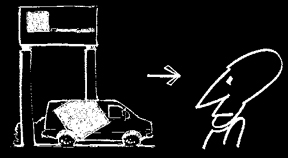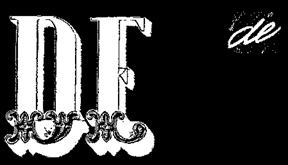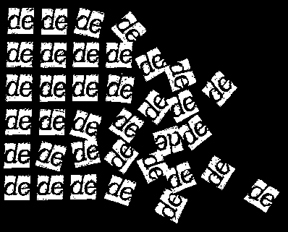jmaDESIGN: Corporate Identity / Corporate Image
Organizations (business, government, or other) interact with the public in many ways. The public may be viewed as past, present, or potential customers or clients. It may also be other organizations, competitors, financial institutions, suppliers, or sub-contractors. The primary goal of a corporate identity program is to let these many different publics know who you are. A strong and memorable corporate symbol does much to help avoid confusion with the competition. It acts as a focal point for identification. The mark, however, is secondary to an overall consistent image.

The public makes immediate value judgements based on the appearance of corporate stationery, publications, advertising, buildings, interior spaces, and signage. An effective corporate identity program must take all of these individually and collectively and ensure that the image they convey is both correct (as desired) and consistent. When properly coordinated, an organization’s identity elements reinforce each other and stand out from the noisy environment. Together, they create an impression of efficiency and imply a concern for quality.

When a formal, organized and planned identity program does not exist, an identity will, never the less, be established through action and inaction. A confusing, counter-productive, and incorrect identity is all too easy to establish.

There are many proven advantages to a professionally produced corporate identity program. Financial savings can be significant. In fact, it is reported that one multinational Fortune 500 firm saved over $217,000.00 just in the printing of forms as a result of implementing a new corporate identity program. With an identity program in place, new communications pieces need not be started from scratch. Significant savings in facilities management costs may be realized when standards for purchasing and expansion are established and followed. A high quality, consistent image has also been shown to increase the market value of a company’s stock. In addition, employee morale improves with the implementation of a comprehensive corporate identity program.
The intangible benefits of improved image stability to service, products, and management are also considerable.
The form of an identity program must be rooted in the goals of a firm. It is necessary for the identity designers to work directly with the highest level of management to establish policy and long range objectives. Interaction at this level, combined with an objective study of the corporate organization, allows the designer to clearly establish the objectives of the identity program.
A total identity program may eventually involve architects, advertising specialists, printers, interior designers, and a variety of specialists in addition to the main identity designers. The coordinated involvement of all of these people in the design process requires a clear statement of goals, and a commitment to the importance of the program.
A properly managed corporate identity program should have a minimum useful life of five years, with certain portions of it lasting considerably longer.
Priorities for the implementation of a new identity program must be established at the outset of the project. The economic advantages of a phased implementation must be weighed against the desire for a complete and rapid changeover. It may, or may not, be desirable to phase in new materials as old ones are exhausted. A program to promote the changes to the public must also be planned.
One key to the success of an extensive corporate identity program is the Corporate Identity Manual. The manual is a management tool to coordinate the efforts of everyone involved in the implementation of the identity program. It is a style guide that promotes standardization. In addition to important information regarding everything from the corporate symbol to furniture, the Corporate Identity Manual must contain a message from the chief executive of the organization. This message should reinforce the importance of both the changes being made and of following the guidelines that the manual establishes. The manual also provides detailed guidance for the maintenance of the program when the consultant is no longer involved. In large, or particularly dynamic, organizations the Corporate Identity Manual (and the entire program) must be viewed as being in a continual state of evolution. Procedures should be established for making the changes that will inevitably be required. In today's world this probably means that the Corporate Identity Manual will be an electronic document that is easily updated and readily accessible to everyone that needs it rather than a costly printed piece as they have traditionally been done in the past.
Identity Elements
The following list of identity elements is not complete, nor would all of these elements be required for all programs.
SymbolLogotype
Type Styles
General Typographic Rules
Legal Signature Arrangement
Signature and Applications
Literature
Advertising
Electronic Media
Signage<br>
Improper or Forbidden Signature Use
Color Standards
Graphic Formats
Grids
Guidelines
Stationary
Forms
Report Covers
Packaging
Literature
Advertising
Signage
Vehicles and Equipment
Premiums and Novelties
Legal Protection of Trademark
International Applications
Environmental Design
Clothing and Fabric
Furniture and Interior Standards
Product Design Standards
Electronic Media Standards
Program Steps
The steps required to complete a comprehensive identity program are as follows:
Preliminary Research
Existing Materials
Audiences
Organization
Background
Attitudes
Legal Requirements
Competition
Summary of Research
Integration of additional info resulting from summary review
Review of Research with client
Establishment of goals and objectives
Preliminary Design
Selection of Scheme for Development
Design Development
Refinement
Manual Design
Implementation
Post Implementation Evaluation
Ongoing adjustments based on changing corporate goals and objectives

The Challenge of Today's Dynamic Business Environment
As a successful business manager today you do not need to be reminded of the challenges you face. You must, however, be on constant alert for new ideas and approaches to help you deal with increased competition, corporate takeovers and mergers, diversification, and rapid technological change. Dealing with your corporate identity and image in terms of marketing strategy is one such approach.
Survivor Strategy
Those companies that survive employ a strategy that involves several common attributes in addition to quality products and/or services.
• The survivors use innovative marketing methods and messages.
• The survivors define their market so that they own a unique position.
• The survivors project a clear, consistent image.

Making Your Strategy Work
At the heart of your strategy is your marketing plan. A written marketing plan should exist to serve as a point of reference when strategic decisions are being made. It must not, however. Be so inflexible that it cannot be modified in response to changing market conditions. A marketing plan produces results when its goals are transformed into actions that communicate to your customer. The actions can be in the areas of advertising, corporate identity, products, services, sales and public relations. A traditional marketing plan seldom defines these actions or how they must all work together. It is essential that this additional planning step be taken.
Corporate Image
The implementation of your advertising, corporate identity, products, services, sales, and public relations forms a corporate image. Corporate image is, in essence, the consumers' perception of your company. It is an image in his mind that is heavily influenced by what is already there. When dealing with corporate image you never begin with a clean slate. Everything you do will be subjectively interpreted.

Image Blur
There are many individual elements that all combine to establish the image of your company in the mind of the consumer. If all of these elements are not communicating the same positioning message, then you suffer from the phenomena of "image blur". The effects of image blur can be subtle or catastrophic.
Blur is the result of failing to recognize the number of messages you send out to the consumer and a failure to coordinate those messages. These problems usually result from a poorly defined or nonexistent marketing goal.

Image Lag
Image Lag is usually the result of an inflexible marketing plan that does not keep up with the changes that your business in undergoing. Your image may be sharply focused, but it is focused on your past. To avoid image lag you must develop a program that continually monitors your image in relation to your corporate direction and goals. You must be planning now for your future image. Otherwise the time that it takes to implement change will always leave your image lagging behind reality.

Corporate Identity
The terms corporate image and corporate identity are often confused or interchanged. This is unfortunate because it tends to obscure the real issues. Corporate identity is only one of the tools that you use to establish tour corporate image. The most significant aspect of your corporate identity is that it influences everything else that you do. It is always there, in some form or another. The effects are great in the long term even if they are subtle in the short term.

Identity Thermodynamics
An obvious, but seldom acknowledged fact is that your identity program will disintegrate over time unless energy is put into maintaining it. Random changes will accumulate until all semblance of a corporate identity program is gone. A corporate identity program cannot be static, and you must work to hold it together.

Crisis Management
If you look at the history of any corporate identity program you will find an effectiveness curve that climbs as the program is developed, peaks when it is fully implemented, and then begins to decline until a crisis is reached. Nothing is done to anticipate and accommodate change. The program gradually loses its effectiveness until a crisis forces a major, reactive, often traumatic, response.

Effectiveness of Dollars Spent
Though you seldom add them up, you spend a lot of dollars in the various areas that create your corporate image. If these individual programs do not consistently support your marketing plan, then the effectiveness of those dollars is reduced. While the expenditures for corporate identity development do not approach those of advertising, identity and advertising are so thoroughly intertwined in image creation that the impact of those corporate identity dollars is enormous.

Solution
The solution to these corporate identity and image problems is five fold:
1 Knowledge
Every employee must know and understand what image you are trying to communicate
to your customers, what the standards are, and how subtle things that they
do impact the image.
2 Comprehensive View
The total picture of your marketing plan, identity, advertising, products,
services, public relations, and sales must be kept clear in everyone's mind.
3 Anticipation
Forward thinking, long range planning of identity and image should accompany
any strategic product or service planning and analysis of market trends.
4 Synchronization
Identity, advertising, products, services, public relations, and sales must
all be kept in sync and consistent with corporate goals and objectives.
5 Review
Periodic or ongoing reviews of the image efforts, monitoring of the state
of your image in the minds of your consumers, and evaluation against corporate
goals and objectives is essential.
Needs Analysis
In the early stages of any identity development or review program it is important to do a preliminary needs analysis. This is accomplished through a series of informal interviews with corporate personnel and a candid look at your image and identity from the outside. This needs analysis will establish a list of preliminary goals and objectives for any work that is to follow.
Image Audit
Unless the image and identity problems are very simple and clear cut, it is important to do an image audit. An image audit takes the concept of needs analysis much further. Customers, employees, and even suppliers are polled for their perceptions of your company and your competitors. This information is gathered, tabulated, and analyzed is such a way as to give you considerable insights into the state of your identity and provides significant clues to actions you should take. The image audit will tell you if your customers perceive you in the way that you wish to be perceived. It will help to point out differences between your goals and your actual performance. It will help you to see if your employees see the company the way you think they should, and if their perception differs from that of the customers.

Master Plan
With the insights gained in the needs assessment and image audit process, it is possible to develop a master plan for your image development. It is essential that key management personnel be involved in this process, along with any advertising, corporate identity, and public relations consultants. The traditional marketing plan should be expanded at this point to include the development and implementation of any desired identity changes.
Design Development
With the master plan in hand it is safe to begin the design process. This could entail graphics, advertising, facilities, products, packaging, vehicles, signage, public relations, publications, electronic media, or any number of other areas. The key to the successful implementation of this design activity is coordination. The efforts of everyone involved must continually be checked against each other and against the master plan.

Identity Manual
The traditional repository for all corporate identity standards and examples is the Corporate Identity Manual. This manual serves the useful purpose of providing a place to go for information and guidance. It is important, however, that this manual be flexible enough to accommodate the change that will be inevitable. The manual is never "done". It must be updated on demand. Electronic publishing and the internet now make it possible to create a "living" corporate identity manual at a fraction of the cost of traditional print manuals.
Implementation Management
When decisions are made and standards set the job is only half done. The interpretation and implementation of those standards is an ongoing process that must be managed. This management can be internal or external, but it must not be left to chance.
Identity Maintenance
Since identity programs are not static and will run down or disintegrate if not properly maintained, it is essential to establish a program of review and update.
Active Image Management
The way to improve the image effectiveness curve is through active image management. Avoid falling into the caretaker trap where all you do is police a system established some time in the past. Introduce and actively promote the ongoing review and analysis of your image.
John Ayotte 2001
Page updated: March 6, 2015 16:49
